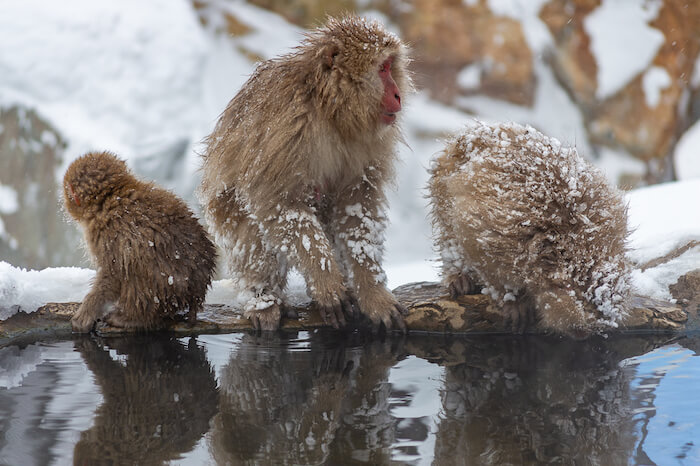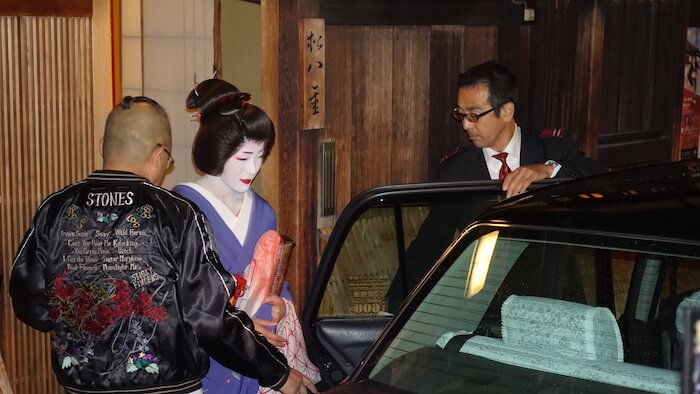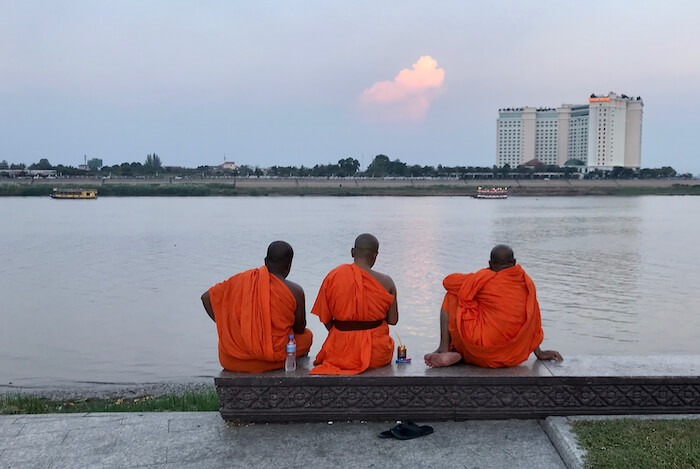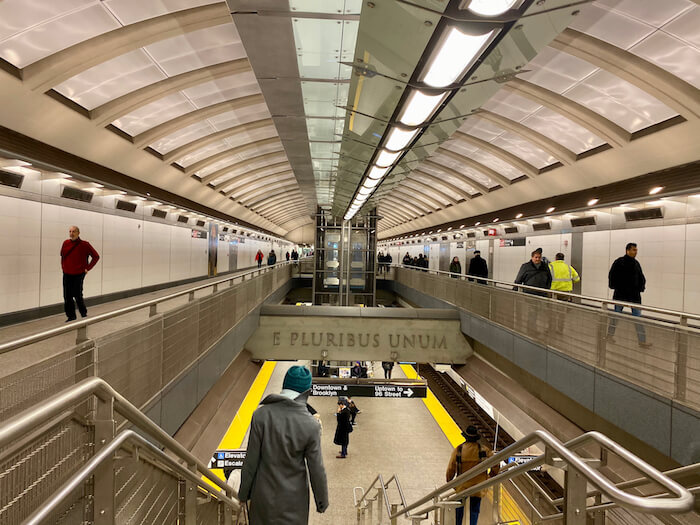16 Unique Things to Do in Japan for a Japan Travel Itinerary
Japan is a must-do destination for many travelers. The country has some very unique places to go and things to do. Having a hard time deciding? Here’s some help: 16 Unique Things to Do in Japan for a Japan Travel Itinerary by travel bloggers from around the world.
How about an evening at a Robot Restaurant? Or a Tokyo Cat Café? Want to see snow monkeys? Or, how about a stay in a Kyoto Ryokan?
Or learn which temples in Kyoto to see? How about biking Shimanami Kaido? Taking Ninja lessons? There are so many unusual things to do in Japan, it’s hard to list them all. Read about some of the best things to do in Japan from travel bloggers from around the world.
After you’ve booked your trip, you want to learn all that you need to know before you go.
This post contains Affiliate Links. We receive a small commission if you use our link. It doesn’t cost you any extra.
Unique Things to Do in Tokyo

Tokyo Robot Evening Cabaret Show
Alexander Waltner, Destinavo
The Robot Restaurant in Tokyo is a fascinating tourist attraction where you get to see a robot show filled with neon, glitter, flashing lights, glowsticks, dancers and performers who will be roleplaying and ”fight” each other. It should be on your list for what to do in Tokyo at night.
It’s not really a restaurant, but you can get a classic bento box served while watching the show. Don’t come here for the food, instead, go for the entertainment. It will be 1.5 hours of eye-catching moments where you will be happily surprised from time to time.
Try to get seats in the front row and book your tickets ahead. The Robot Restaurant is located in the Shinjuku district, in Kabuchiko. The price of a ticket goes for about 70 USD, but sometimes you can find same-day deals for less.

Cat Café—One of the Cool things to do in Japan
Sylvia Van Overvelt, Wapiti Travel
When people think about a cat café they automatically think about Japan. Nonetheless, cat cafés originated in Taiwan but eventually became more popular in Japan. Recently similar cafés have been popping up in other countries but the only country where it really blossoms and became part of a tradition is in Japan. It is one of the cool things to do in Japan.
Being cat lovers ourselves, and not having similar cafés in our home country, we were anxious to find out how a cat café would look like. We immediately went looking for a café upon our arrival in Tokyo. It’s not hard to find one, in Tokyo alone there’re dozens with a particularly high concentration in the Shibuya district.
We opted for the beautifully designed Mocha café. Unfortunately, once we were there, it was a bit disappointing. We were very excited to say hi to the cats but the cats were not all that pleased with so much attention. They walked away uninterested to hide or rest at places they couldn’t be reached.
Only when the owners of the café came in, they went to them to be petted.
It turned out our mental image of a cat café was completely wrong so we’re glad we visited one during our 5 days in Tokyo.

Watch Sumo Wrestling
Matilda, The Travel Sisters
Watching sumo wrestling is a unique thing to do when visiting Japan. Sumo is considered Japan’s national sport, but even if you don’t enjoy wrestling or sporting events, watching a sumo match is a fascinating cultural experience. Sumo wrestling matches include many traditions and rituals dating to ancient times such as singing, salt-tossing, and foot stomping – in fact, the actual wrestling portion of a match is very brief.
One of the best ways to see sumo is to get tickets to one of the six grand tournaments held each year in Japan each lasting for fifteen days. If you are not in Japan during a grand sumo tournament but still want to see sumo wrestling, you might be able to visit a sumo wrestling stable (a house where wrestlers live and train together) to watch their early morning practice sessions.
For tips on how to buy tickets to a sumo tournament (it is best to buy tickets in advance), here is a guide to watching sumo in Japan.

Sleep in a Capsule Hotel
By Mike, 197TravelStamps
Sleeping in a capsule hotel is something truly Japanese. Capsule hotels offer small sleeping pods that are built into the walls instead of a proper room. All common areas such as bathrooms and relaxation areas are shared with the other guests. Since space is so precious in Japan, the concept of a capsule hotel makes a lot of sense.
On our quest for a hotel in Tokyo, we also wanted to spend a night in a capsule hotel. The choice ranges from ultra-budget to downright luxurious. Nowadays, it is also possible to book capsules for coupes that can fit two people. We opted for a more traditional house in Asakusa and we weren’t disappointed. Upon entering the hostel, we had to remove our street clothes and put on comfortable Japanese style clothes. The capsules were spacious enough and even had a little TV inside. It wasn’t much use, however, since the channels were Japanese only.
In addition to the sleeping area, our hotel had a spacious relaxation and spa area. And all that for a price of around 30 USD per night in Tokyo. An incredible Japanese experience and an affordable night in Tokyo in one!

Visit a Maid Café
Pari, traveling Pari
I love Japan because it’s one of the places where you can experience many unique things like – go Mario karting in traffic, visit a cosplay café, see people dressed up in Lolita Style, go Geisha spotting, etc. I was keen to experience all this and more.
When I visited Tokyo, I decided to go to a Maid café, a cosplay café where the waitresses dress up as maids. It was a mixture of fun, cuteness, and weirdness thrown in together which makes it an essentially Japanese experience. There are times when I was embarrassed to be there. For example, when I had to wear bunny ears and when I had to sing cutesy Japanese rhymes with the waitress as part of food ordering ritual. However, if you take it all in stride as part of the experience, you’ll enjoy every minute of it.
Outside of Tokyo

Experience Ikaho Onsen
Lena Scheidler, The Social Travel Experiment
If you are looking for an Onsen (Japanese Hot Spring) experience that is truly off the beaten path, unique and unforgettable, I recommend you visit Ikaho Onsen.
This little Onsen town has everything: delicious food, a relaxed atmosphere, countless wonderful hot springs to choose from and other entertainment that you can’t miss when visiting an Onsen town like little arcades, table-tennis parlors, sweets shops, and some cute shrines. Everything here revolves around the stone steps at the heart of the village of which there are 365.
While you are there don’t forget to eat some fresh Onsen Manju, sweet red bean paste filled steamed dumplings. Take a bath at the Rotenburo (open-air bath) and when your feet are tired from climbing all the steps over and over again relax at one of the free foot baths, called Ashiyu, around town.
You can reach Ikaho Onsen comfortably by bus from the Shinjuku bus terminal in Tokyo. A bus leaves every hour. The trip takes just 2.5 hours and costs 2600 yen (roughly 25 USD).

Go to the Jigokudani Snow Monkey Park
Ben McLaughlin, Horizon Unknown
Jigokudani Snow Monkey Park is a unique attraction not far from the Japanese city of Nagano. During the cold winter months, these Japanese Macaque Monkeys descend from the snowy peaks, seeking the warm water pools of Jigokudani.
After getting off the bus from Nagano, there’s a 30-minute walk to where the hit pools are. It’s a flat and easy walk, but might be a little slippery due to winter conditions.
Once at the pools, the monkeys are everywhere. It’s a great way to observe these interesting creatures. If they aren’t escaping the chilly winter winds, they can be found scavenging for food beneath the snow, or running around and playing with each other.
It’s important to keep in mind that these monkeys are still wild animals. Respecting them and their environment is very important.
There is a small information center if you would like to learn more about these monkeys and how they live. As no humans are allowed to swim in the hot water, this information center is a great place for a warm-up break!

Have a Tasting at the Cup Noodle Museum
Paula Barnes, The Travelling Expat
If you want to get out of Tokyo for the day, then head down to Yokohama which is only a short ride via train from Naka Meguro. While there you can not only visit Asia’s largest Chinatown but also check out the cup noodle museum. The cup noodle museum is precisely what the name states, a museum about the history of cup noodles and it’s founder Momofuku Ando.
This informative museum explains the discovery of packaged ramen noodles, cup noodles and the most recent invention, noodles that can be eaten in space.
If you arrive early enough, book a spot to be shown how to make your noodles and then have the chance to take them home with you. Beware the booking spots fill up fast and take approximately an hour to complete.
Last but not least enter the world of noodles at the noodle bazaar where you can choose a vending machine from your country of choice. Grab a ticket, hand it over for your selection of cuisine and in return a steaming hot noodle dish is ready. For those interested, I chose my favorite Indonesian noodles mee goreng, and I wasn’t disappointed.
Choose to reuse and ditch disposable with a BPA/BPF/BPS-free water bottle. Free shipping on orders over $60 + free returns.Shop CamelBak Water Bottles
Unique Things to do in Osaka

Try an Osaka Cooking Class
Amber Hoffman, With Husband in Tow
Taking a cooking class when traveling is a great way to get hands-on experience in learning a new skill. But, more importantly, it helps to better understand a culture through food.
Osaka is the perfect city to take a cooking class because it is one of the most food-focused cities in a very food-focused country.
When it comes to what to eat in Osaka, local specialties like okonomiyaki, the Japanese style pancake, and takoyaki, which are fried octopus balls, are definite must-eats. Learning to cook these specialties, while learning about the history of Japan’s unique culture is certainly a fun thing to do in Osaka.
There are several types of Osaka cooking classes. You can take a class at a cooking school or restaurant, or locals host cooking classes in their homes. By taking an at-home cooking class, you can learn to make these Osakan dishes, learn about Japanese food culture, and see inside a home in Japan. Many cooking classes also include tea ceremonies and sake tastings as well.
Best things to do Kyoto Area

Stay in a Japanese Ryokan
Sarah Carter, A Social Nomad
Japan is a blast to all the senses and incredible rush to experience. There’s no better place, to my mind, to unwind and escape the city than to stay in a ryokan. You will find ryokans throughout Japan, although Kyoto and Tokyo host some of the most luxurious ryokans around.
A ryokan is a traditional Japanese inn that was created during the Edo period (1603-1838) for Japanese travelers who were moving between Kyoto and Tokyo. After a hard day of travel, they would unwind and relax in the privacy of their room. Ryokans involve elaborate, long dining experiences and bathing in either shared or private onsen baths. They’re a great way to immerse yourself in traditional Japanese culture.
From wearing traditional Japanese clothing in the yukata to taking meals in your room and sleeping on comfortable futons on the floor, a stay in a ryokan is a great way to experience Japan. You’ll find ryokan hosts gracious and helpful with all the aspects of ryokan etiquette, even if you don’t speak Japanese.

Go Temple Hopping in Kyoto
Paul Fournier, Journey Compass
If you’re a culture buff like me, temple hopping is one of the best attractions of Kyoto. Visiting the right temples can give you that majestic feeling, like you’ve been transported straight into a scene from some epic historic movie.
Kyoto has over 1600 temples, but not all can be visited or are interesting to visit. Some people prefer to look for hidden gems to avoid the crowds, but I personally don’t mind people around, as long as they don’t trample me and are respectful – I enjoy being around people.
With that in mind, here are the 3 temples that I can recommend most:
Kiyomizu-dera Temple – This to me is the most epic of temples. Walking up the stairs, with the huge gates arching over you, it really gives you that surreal otherworldly feeling. As you reach the top, the observatory also gives you a great view of Kyoto’s skyline.
Kinkaku-ji Temple – Also known as The Golden Pavilion, because of its yellow color, and when the sun shines just right it gives the temple a glowing appearance. The pond is well worth a look too, as is the park where you find some of the more quiet spots.
Ryoan-ji Temple – The highlight of this temple is not the temple itself, but the garden within, which you view from the veranda inside the temple. It’s a very elegant dry garden, well worth a visit if you enjoy zen gardens.

Geisha Spotting in Kyoto
Melissa Smuzynski, Parenthood and Passports
Before visiting Japan, I thought geishas were a fascinating part of Japanese history. However, upon arriving in Kyoto, I quickly realized geishas aren’t just a part of the country’s history, they remain a unique and treasured part of present-day Japan, as well.
Known for their white makeup, elegant kimonos, and perfect updos, geishas are young women who have train for years in in the traditional Japanese arts. They perform at high-end dinners, special events, and private tea houses, where invitations aren’t easy to get nor are the performances cheap to attend. For this reason, geishas are treated like celebrities in Japan. They don’t walk the streets or pose with tourists, although you will find plenty of other tourists dressed as geishas doing exactly that.
Spotting a real geisha requires you to resort to paparazzi tactics. The best way to catch a glimpse of one is to head to Kyoto’s Gion district around dusk when geishas are typically heading to a performance. Look for the crowds of people and for taxis or hired drivers parked directly in front of the door to a building. Wait there with your camera ready for the geisha to emerge. She will quickly be escorted from the door to the car and whisked away as the cameras flash. Geishas are often accompanied by a younger apprentice, called a maiko. Dressed similar to a geisha but wearing a more muted kimono, she will likely follow the geisha in a second taxi. This will give you a more chance to see one of these traditional Japanese entertainers. And if you are lucky enough to spot one, its an encounter you won’t forget.
Find other great things to do in Kyoto with kids (or without) here.

Ninja Training Lessons
Priya, Outside Suburbia
One unique activity my kids were excited about trying when we were in Japan was the Ninja Training lessons in Kyoto. Not many places in the world where you can you dress up like a Ninja and throw shuriken, use the ninja sword and learn some super cool ninja moves.
A Ninja Dojo in Kyoto offers this unique experience in the form of a traditional ninja training class. It is a tatami dojo where adults and kids can learn Ninja meditation, Ninja breathing, Ninja walking and also experience a ninja trick house. After everyone changed into the black Ninja gear, the demonstration and training started. The first lesson was to learn the numbers in Japanese followed by some Ninja meditation and breathing. After some more training on how to move without being seen, they were giving each a shining Sword and training on how to use the sword slowly like a Ninja. We learned that a Samurai, observed strict rules about honor and combat, while a Ninja was a covert agent whose functions included espionage, sabotage, infiltration, assassination and guerrilla warfare.
My kids were 14 and 18 when we visited Kyoto but it is perfectly safe for adults and younger children as well, they have rubber shuriken and short fukiya (blow darts) for kids.
More Cool Japan Attractions

Japanese Flower Park
Rhonda Krause, Travel? Yes Please
Japan may be famous for its cherry blossoms and viewing parties that celebrate the arrival of spring, but flowers can be enjoyed year-round at Japan’s many flower parks. Across the country, there are gardens dedicated to showcasing a variety of flowers from wisteria, nemophila, creeping phlox, plum blossoms, tulips, cosmos, roses, poppies, sunflowers, and more.
One of the largest flower parks in Japan is Tottori Hanakairo, the Tottori Prefectural Flower Park. There are many different areas to explore including the vibrant Flower Hill, a European garden, lily exhibit, glass greenhouse, and a pond with floating sunflowers. There’s even a covered, elevated pathway circling the park so visitors can enjoy the flowers no matter the weather.
Tottori Hanakairo Flower Park is located near the city of Yonago, but no matter what region of Japan you visit, you’re sure to find a lovely flower garden to relax in and admire.

Visit Koyasan Japan
Mike Sill, Live Travel Teach
Koyasan Japan is a marvelously unique place in Japan filled with natural splendor and cultural authenticity. The mountain retreat is the home to Japanese Buddhism and has since become a training ground for wayward monks while also providing a tranquil destination for travelers like you.
Kobo Daishi founded Koyasan, also known as Mount Koya, around 819 AD is said to still be meditating deep within these mountains. The grounds around Mount Koya have been used as a Buddhist cemetery for over a millennia filling the surrounding forest with over 200,000 graves and turning this destination into a gorgeous UNESCO site. The gravestones come in all shapes and sizes, but I found the ancient moss-covered ones the most beautiful.
You can walk through the forest and explore the cemetery or stay near the main temple buildings. Book a retreat at one of these monasteries or wander all the way through the Sando and reach Okunoin, a mausoleum dedicated to Kobo Daishi himself. Whatever you decide to do at Koyasan you are sure to enjoy this unique opportunity in Japan!
Best Things to Do Hiroshima Area

Hiroshima Peace Memorial Park
Sally Lucas, our3kidsvtheworld
One of my best experiences in Japan was visiting the Hiroshima Peace Memorial Park. We did it from Osaka on the Shinkansen, the trip takes 2 hours. I found the Hiroshima Memorial Park to be incredibly moving and I love that the Japanese have created this area to honor the lives lost but also to educate others on why we should never experience this type of devastation again.
We arrived on the free shuttle bus provided and were dropped at the entrance close to the A-Bomb Dome. This is the exact location the nuclear bomb was dropped on 6th August 1945. The nuclear bomb detonated 600m above this structure and it was the only remaining structure other than dust and ash afterward. The Flame of Peace among others is another of the main monuments dedicated to those affected at this site. The flame will continue to burn until the last nuclear bomb on earth is disposed of. I hope I return one day to find this flame extinguished.

Shimanami Kaido
Samuel Smith, Travelling Sam
The Shimanami Kaido is a unique and exciting way to explore Japan; taking you past ancient temples, through stunning countryside and across the world’s longest suspension bridge. The 60km long road and bridge cycle way connects Onomichi on Honshu with Imabari on Shikoku, passing through six islands en route. Whilst it is possible to cycle the full length in one day, many people prefer to take two or more days in order to explore the islands more thoroughly.
Fear not if you do not have your own bike: there are two rental systems currently running for the route. Giant Rentals has a terminal at each end of the route and offer a wide range of high-quality bikes. Alternatively, the ‘regular rental system’ offers 14 different terminal stops along the Shimanami Kaido where bikes can be left – allowing you to stop for the night or catch the bus to the end!
Traveling through Asia? Hanoi and Phnom Penh are must-sees.
Do You Have a Place in Japan to Add to this List? Let Me Know by Leaving a Comment.
Please Pin and Share








I haven’t had a chance to visit Japan yet, but I have a long bucket list of things I’d do and see when I go. And at the top is seeing snow monkeys. How cute!!! ~ Sage Scott, the Everyday Wanderer
Tokyo seems overwhelming to me. Having a list like this makes it seem not only manageable but a must-see!
Candy,
Thanks for commenting. Glad you found the list helpful.
Sue
Great list with some really fun ideas! Need to get back to Japan clearly! So much to do…
I was really hoping to get to Japan last year but we bought a house instead 🙁 Oh well! I really want to see the snow monkeys and the robot show, a friend went a couple of days ago and it looked SO fun!
Japan is a dream country with so many wonderful experiences. Staying in a capsule hostel would be quite unique.